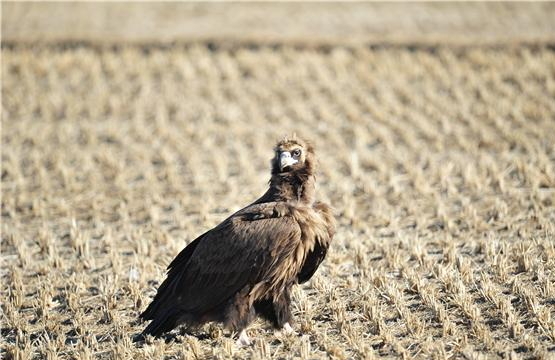Korea scientists successfully analyzed the genome of the cinereous vulture, a large bird of prey found across Europe and Asia, for the first time, the Science Ministry said Monday.
The findings are expected to offer clues on the genetic structure of the bird, scientifically known as Aegypius monachus, such as why it does not contract diseases from eating rotten meat.
Scientists took blood samples from two live vultures and performed an analysis of the first whole genome and transcriptome of the birds by using Next Generation Sequencing ― a type of DNA decoder ― and bioinformatics technology. Bioinformatics involves using a computer to analyze and process huge amounts of biological data.
 |
The cinereous vulture. (National Science Museum) |
Through five-month-long genome sequencing, researchers identified 200,000 unigenes, genome fragments that each has unique characteristics. They said these are “candidates” that could be identified as genes with further analysis.
Scientists found that the bird’s genes related to immunity and gastric acid secretion were unusual compared to other animals. This can explain why the bird, both a hunter and a scavenger, is not affected by pathogenic bacteria after ingesting decayed meat.
They also found that vultures became genetically separate from falcons about 80 million years ago.
According to the researchers, the bird carries out a crucial ecological role by eating animal carcass. This prevents the bacteria from the dead bodies from infecting other animals or humans.
But vulture populations have been decreasing due to the diminishing number of dead livestock, coupled with the increase in poisonous chemical substances that have been released into the wild.
Researches said there have not been enough studies on the ecological role and biological uniqueness of the birds.
“Genome analysis of the vulture will provide ground-breaking information toward research of the bird,” said project leader Paek Woo-ki of the National Science Museum, saying the study will be a milestone in efforts to preserve the vultures.
The cinereous vulture is categorized as “near threatened,” according to “The IUCN Red List of Threatened Species” by the International Union for Conservation of Nature and Natural Resources. In Korea, it is considered an endangered animal and is designated as a national monument.
The research was conducted by the National Science Museum, the Cultural Heritage Administration, Theragenetex Bio Institute and the Korean Bioinformation Center of the Korea Research Institute of Bioscience and Biotechnology.
By Yoon Min-sik (
minsikyoon@heraldcorp.com)



![[Music in drama] Rekindle a love that slipped through your fingers](http://res.heraldm.com/phpwas/restmb_idxmake.php?idx=644&simg=/content/image/2024/05/01/20240501050484_0.jpg)



![[New faces of Assembly] Architect behind ‘audacious initiative’ believes in denuclearized North Korea](http://res.heraldm.com/phpwas/restmb_idxmake.php?idx=644&simg=/content/image/2024/05/01/20240501050627_0.jpg)
